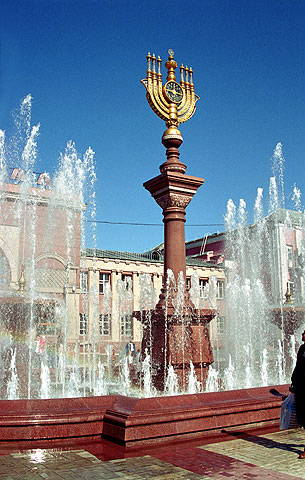 The Russian Empire, as the name suggests, was an Empire for Russians. However, because of its vast territory, it contained many areas in which other ethnicities were the local majority. These areas often faced mistreatment from the Russian authorities, and were seen as foreigners even in their own homelands.
The Russian Empire, as the name suggests, was an Empire for Russians. However, because of its vast territory, it contained many areas in which other ethnicities were the local majority. These areas often faced mistreatment from the Russian authorities, and were seen as foreigners even in their own homelands. One of the promises of the Bolshevik revolution was that these various minorities would gain autonomy and self-determination in the Soviet state, which helped the revolutionaries find recruits among non-Russians. Once the Empire was overthrown, it was time to make good on the promise. Because the new Soviet authorities didn't want territories to start seceding left and right, they came up with a system by which each recognized nationality would receive a semi-autonomous state within the union.
While some nationalities had clear historical identities, languages, territories, etc. others were trickier. Some were heavily divided along tribal lines, and had little nationalistic desire. Others lacked things like a written language or a shared culture. One of the trickiest cases was the Jewish population - they had all of the qualifications except for a historical territory within the country.
In 1928, a solution was found. As a quick glance at a map will tell you, Russia has more territory in Siberia than it knows what to do with, so a patch of land along the far eastern border with China was selected as a new Jewish homeland. Although this might seem like a strange and arbitrary choice of location, it had a few key benefits for the Soviet government. First, it was felt that creating a Jewish homeland somewhere in the European part of the country would only exacerbate the antisemitism among the population. Second, the Siberian border regions were largely unsettled, and the hope was that the Jewish territory would provide much-needed development and protection.
For obvious reasons, not many Jews were keen on the idea of abandoning their homes and trekking thousands of miles to the Siberian wilderness. By 1948, 30,000 Jews had moved to the region, many fleeing mistreatment under Stalin. After the establishment of Israel, the majority emigrated, and only around 2,000 Jews remain today.
Although most of the Jewish population has left, the cultural institutions remain. In the Jewish Autonomous Oblast, the local schools teach Yiddish, Yiddish radio and newspapers are in operation and children learn about Jewish history and traditions. The capital Birobidzhan features statues of Jewish cultural icons, and a giant menorah sits in the town square.
No comments:
Post a Comment